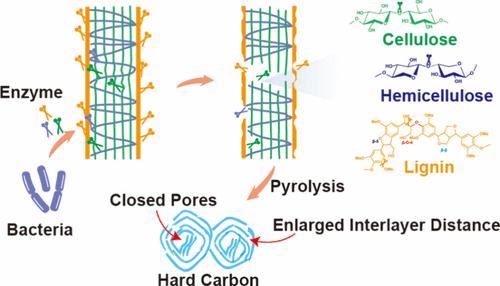基于快速平台动力学的硬碳钠离子电池阳极结构的木质纤维素分解细菌工程
IF 15.6
1区 化学
Q1 CHEMISTRY, MULTIDISCIPLINARY
引用次数: 0
摘要
木质纤维素生物质衍生的热解硬碳(LCB-HC)作为钠离子电池(sib)的负极材料具有广阔的商业潜力。LCB涉及多种生物聚合物碳源,包括纤维素、半纤维素和木质素,这些碳源会影响热解HC的形成和微观结构。然而,LCB-HC的平台动力学差是严重限制其具有高功率密度的能量密度的主要障碍之一,这可能是由于层间距离窄,缺乏丰富的闭孔用于Na+的插入/填充。在此,我们提出了一种自下而上的方法,通过使用木质纤维素分解细菌分泌的生物酶在分子水平上调节LCB- hc前体的成分来定制LCB- hc的微观结构。这种温和而高效的酶解途径使椴木的生物聚合物特异性地部分解聚,从而使LCB-HC形成一个小的弯曲石墨畴结构,增加了封闭孔隙,扩大了层间距离,有利于加速动力学的低压平台Na+储存。因此,椴木衍生的HC提供了366.4 mAh g-1的可逆容量,并且即使电流密度增加到1000 mA g-1,也具有74.3%的高原容量保留率。这种微生物化学辅助方法为定制LCB-HC的微观结构以构建高性能SIB阳极材料提供了见解。本文章由计算机程序翻译,如有差异,请以英文原文为准。

Lignocellulolytic Bacterial Engineering for Tailoring the Microstructure of Hard Carbon as a Sodium-Ion Battery Anode with Fast Plateau Kinetics
Lignocellulosic biomass-derived pyrolysis hard carbon (LCB-HC) shows promising commercial potential as an anode material for sodium-ion batteries (SIBs). LCB compromises multiple biopolymer carbon sources, including cellulose, hemicellulose, and lignin, which influence the formation and microstructure of pyrolysis HC. However, the poor plateau kinetics of LCB-HC is one of the main obstacles that severely limits its energy density with high power density, which could be attributed to the narrow interlayer distance and the lack of abundant closed pores for the intercalation/filling of Na+. Herein, we proposed a bottom-up approach to tailoring the microstructure of LCB-HC by regulating the components of the LCB precursor at the molecular level using bioenzymes secreted by lignocellulolytic bacteria. This mild and efficient enzymatic hydrolysis pathway partially depolymerized the biopolymers of basswood specifically, thereby enabling the construction of a small curved-graphite domain architecture with increased closed pores and an enlarged interlayer distance of LCB-HC, benefiting the low-voltage plateau Na+ storage with accelerated kinetics. As a result, the basswood-derived HC delivers a reversible capacity of 366.4 mAh g–1 and performed remarkable plateau capacity retainability with a high proportion of 74.3% even with increased current density to 1000 mA g–1. Such a microbial-chemistry-assisted approach provided insights into tailoring the microstructure of LCB-HC to construct high-performance SIB anode materials.
求助全文
通过发布文献求助,成功后即可免费获取论文全文。
去求助
来源期刊
CiteScore
24.40
自引率
6.00%
发文量
2398
审稿时长
1.6 months
期刊介绍:
The flagship journal of the American Chemical Society, known as the Journal of the American Chemical Society (JACS), has been a prestigious publication since its establishment in 1879. It holds a preeminent position in the field of chemistry and related interdisciplinary sciences. JACS is committed to disseminating cutting-edge research papers, covering a wide range of topics, and encompasses approximately 19,000 pages of Articles, Communications, and Perspectives annually. With a weekly publication frequency, JACS plays a vital role in advancing the field of chemistry by providing essential research.

 求助内容:
求助内容: 应助结果提醒方式:
应助结果提醒方式:


